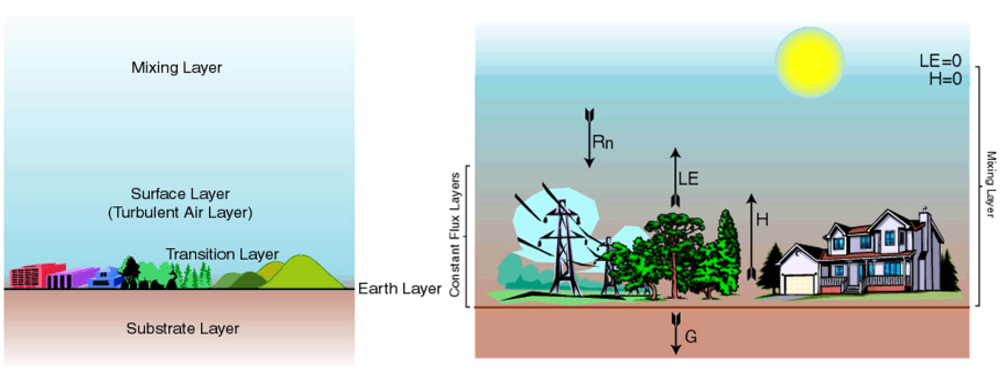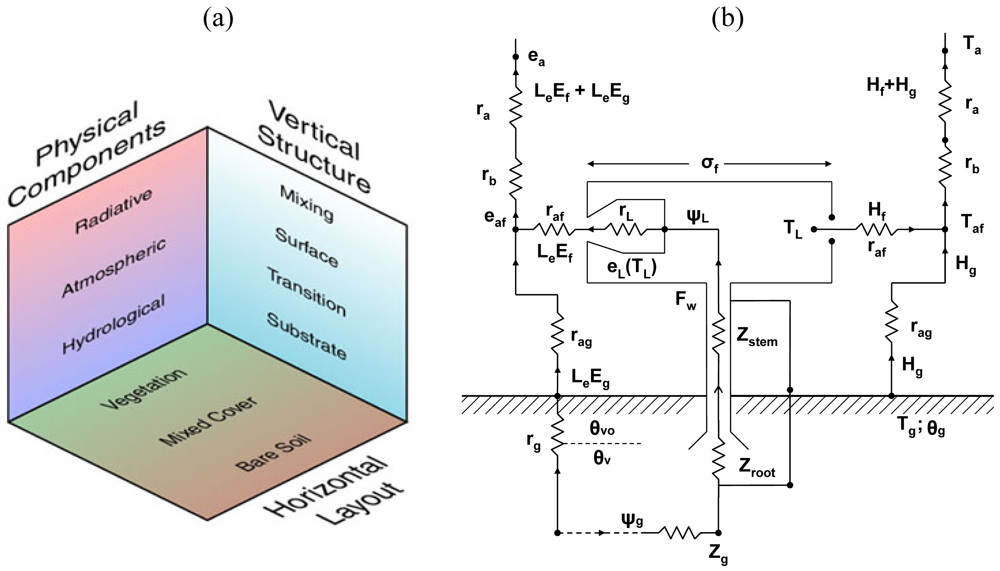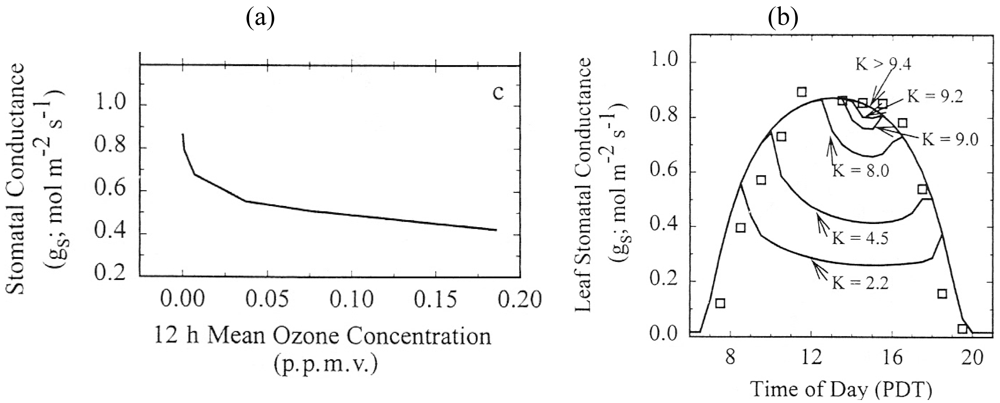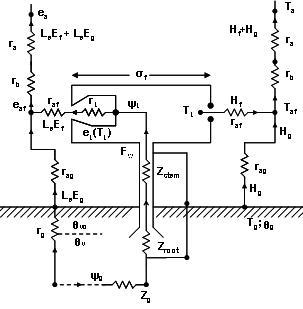An Overview of the Use of the SimSphere Soil Vegetation Atmosphere Transfer (SVAT) Model for the Study of Land-Atmosphere Interactions
Abstract
:1. Introduction
2. Overview of the SVAT Model Architecture
3. Overview of SVAT Model Use
- Evaluation of the land surface parameters simulated by the SVAT model, including sensitivity analysis studies
- Use of the SVAT model as a tool to explore hypothetical scenarios and perform other analysis studies
3.1. Studies based on the evaluation of the land surface parameters simulated by the SVAT model, including sensitivity analysis studies
3.2. Studies based on the use of the SVAT model as a tool to explore hypothetical scenarios and perform other analysis studies
3.3. Studies based on the coupling of the SVAT model to remote sensing observations
4. Discussion and Conclusions
Acknowledgments
References
- Carlson, T.N.; Boland, F.E. Analysis of urban-rural canopy using a surface heat flux/temperature model. J. Appl. Meteorol. 1978, 17, 998–1013. [Google Scholar]
- Olioso, A.; Chauki, H.; Courault, D.; Wigneron, J.P. Estimation of evapotranspiration and photosynthesis by assimilation of remote sensing data into SVAT models. Remote Sens. Environ. 1999, 68, 341–356. [Google Scholar]
- Sellers, P.J.; Mintz, Y; Sud, Y.C.; Dalcher, A. A simple biosphere model (SiB) for use with general circulation models. J. Atmosph. Sci. 1986, 43, 520–521. [Google Scholar]
- Sellers, P.; Randall, D.; Collatz, J.; Berry, J.; Field, C.; Dazlich, D.; Zhang, C.; Collelo, G.; Bounous, A. A revised land surface parameterization (SiB2) for atmospheric GCMs: Model formulation. J. Climatol. 1996, 9, 676–705. [Google Scholar]
- Moran, M.S.; Peters-Lidard, C.D.; Watts, J.M.; McElroy, S. Estimating soil moisture at the watershed scale with satellite-based radar and land surface models. Can. J. Remote Sens. 2004, 5, 805–824. [Google Scholar]
- Cayrol, P.; Chehbouni, A.; Kergoat, L.; Dedieu, G.; Mordelet, P.; Nouvellon, Y. Grassland modelling and monitoring with SPOT-4 VEGETATION instrument during the 1997-1998-1999 SALSA experiment. Available online at: http://www.tucson.ars.ag.gov/salsa/research/research_1999/jafm/CayrolPaper.pdf (accessed November 21, 2007).
- McLaughlin, D. Recent developments in hydrologic data assimilation. Rev. Geophys. 1995, 33, 977–984. [Google Scholar]
- Van Loon, E.E.; Troch, P.A. Directives for 4D soil moisture data assimilation in hydrological modeling. In Soil-Vegetation-Atmosphere Transfer Schemes and Large-Scale Hydrological Models; IAHS Publ.: Maastricht, The Netherlands, 2001; Nr. 270; pp. 257–267. [Google Scholar]
- Moradkhani, H. Hydrologic Remote Sensing and Land Surface Data Assimilation. Sensors 2008, 8, 2986–3004. [Google Scholar]
- Olioso, A. Simulation des 6changes d'6nergie et de masse d'un convert v6gandal, dans le but de relier ia transpiration et la photosynthese anx mesures de reflectance et de temp6rature de surface. Doctorate Thesis, University de Montpellier II, Montpelier, France, 1992; pp. 1–260. [Google Scholar]
- Bruckler, L.; Witono, H. Use of remotely sensed soil moisture content as boundary conditions in soil atmosphere water transport modeling. -Estimating soil water balance. Water Resour. Res. 1989, 25, 2437–2447. [Google Scholar]
- Ottle, C.; Vidal-Madjar, D. Assimilation of soil moisture inferred from infrared remote sensing in a hydrological model over the HAPEX-MOBILHY region. J. Hydrol. 1994, 158, 241–264. [Google Scholar]
- Carlson, T.N.; Perry, E.M.; Schmugge, T.J. Remote estimation of soil moisture availability and fractional vegetation cover for agricultural fields. Agric. Forest Meteorol. 1990, 52, 45–69. [Google Scholar]
- Gillies, R.R.; Carlson, T.N.; Cui, J.; Kustas, W.P.; Humes, K.S. Verification of the “triangle” method for obtaining surface soil water content and energy fluxes from remote measurements of the Normalized Difference Vegetation Index NDVI and surface radiant temperature. Int. J. Remote Sens. 1997, 18, 3145–3166. [Google Scholar]
- Carlson, T.N. An overview of the “triangle method” for estimating surface evapotranspiration and soil moisture from satellite imagery. Sensors 2007, 7, 1612–1629. [Google Scholar]
- Taconet, O.; Bernard, R.; Vidal-Madjar, D. Evapotranspiration over an agricultural region using a surface flux/temperature model based on NOAA-AVHRR data. J. Clim. Appl. Meteorol. 1986, 25, 284–307. [Google Scholar]
- Carlson, T.N.; Capehart, W.J.; Gilies, R.R. A new look at the simplified method for remote sensing of daily evapotranspiration. Remote Sens. Environ. 1995, 54, 161–167. [Google Scholar]
- Gottschalck, J.C.; Gillies, R.R.; Carlson, T.N. The simulation of canopy transpiration under doubled CO2: The evidence and impact of feedbacks on transpiration in two 1-D Soil-Vegetation-Atmosphere-Tranfer models. Agric. Forest Meteorol. 2001, 106, 1–21. [Google Scholar]
- Brunsell, N.A.; Gillies, R.R. Scale issues in land-atmosphere interactions: implications for remote sensing of the surface energy balance. Agric. Forest Meteorol. 2003, 117, 203–221. [Google Scholar]
- Chauhan, N.S.; Miller, S.; Ardanuy, P. Spaceborne soil moisture estimation at high resolution: a microwave-optical/IR synergistic approach. Int. J. Remote Sens. 2003, 22, 4599–4646. [Google Scholar]
- Gillies, R.R. A physically-based land use classification scheme using remote sensing solar and thermal infrared measurements suitable for describing urbanization. PhD Thesis, University of Newcastle, Newcastle, UK, 1993. [Google Scholar]
- Carlson, T.N.; Dodd, J.K.; Benjamin, S.G.; Cooper, J.N. Satellite estimation of the surface energy balance, moisture availability and thermal inertia. J. Appl. Meteorol. 1981, 20, 6–87. [Google Scholar]
- Mehrez, M.B.; Taconet, O.; Vidal-Madjar, D.; Valencogne, C. Estimation of stomatal resistance and canopy evaporation during the HAPEX-MOBILHY experiment. Agric. Forest Meteorol. 1992, 58, 285–313. [Google Scholar]
- Lynn, B.; Carlson, T.N. A stomatal resistance model illustrating plant versus external control of transpiration. Agric. Forest Meteorol. 1990, 52, 5–43. [Google Scholar]
- Carlson, T.N.; Lynn, B. The effects of plant water storage on transpiration and radiometric surface temperature. Agric. Forest Meteorol. 1991, 57, 171–186. [Google Scholar]
- Olioso, A.; Carlson, T.N.; Brisson, N. Simulation of diurnal transpiration and photosynthesis of a water stressed soybean crop. Agric. Forest Meteorol. 1996, 81, 41–59. [Google Scholar]
- Carlson, T.N.; Ripley, D.A. On the relation between NDVI, fractional vegetation cover, and leaf area index. Remote Sens. Environ. 1997, 62, 241–252. [Google Scholar]
- Deardoff, J.W. Efficient prediction of ground surface temperature and moisture inclusion of a layer of vegetation. J. Geophys. Res. 1978, 83, 1889–1903. [Google Scholar]
- Hansen, S.; Jensen, H.E.; Nielsen, N.E.; Svendsen, H. Simulation of nitrogen dynamics and biomass production in winter wheat using the Danish simulation model DAISY. Fertilizer Res. 1991, 27, 245–259. [Google Scholar]
- Mascart, P.; Taconet, O.; Pinty, J.P.; Ben Mehrez, M. Canopy resistance formulation and its effect in mesoscale models: a HAPEX perspective. Agric. Forest Meteorol. 1991, 54, 319–351. [Google Scholar]
- Gillies, R.R.; Carlson, T.N. Thermal remote sensing of surface soil water content with partial vegetation cover for incorporation into climate models. J. Appl. Meteorol. 1995, 34, 745–756. [Google Scholar]
- Carlson, T.N. Regional-scale estimates of soil moisture availability and thermal inertia using remote thermal measurements. Interpretation of thermal infrared data. Remote Sens. Rev. 1985, 1, 197–247. [Google Scholar]
- Todhunter, P.; Werner, T. Intercomparison of three urban climate models. Bound. Layer Meteorol. 1988, 42, 181–205. [Google Scholar]
- Ross, S.; Oke, T.R. Tests of three urban energy balance models. Bound. Layer Meteorol. 1988, 44, 73–96. [Google Scholar]
- Andre, J.C.; Goutorbe, J.P.; Perrier, A. HAPEX — Mobilhy: a hydrologic atmospheric experiment for the study of water budget and evaporation flux at the climatic scale. Bull. Am. Meteorol. Soc. 1986, 67, 138–144. [Google Scholar]
- Powell, D.B.; Thorpe, M.R. Dynamic aspects of plant-water relations. In Environmental Effects on Crop Physiology; Landsberg, J.J., Cutting, C.V., Eds.; Academic Press: New York, NY, USA, 1977; pp. 259–279. [Google Scholar]
- Landsberg, J.J. Physiological Ecology of Forest Production. Chapter 7: Water Relations; Academic Press: London, UK, 1986; pp. 1–198. [Google Scholar]
- Hunt, E.R.; Running, S.W.; Federer, C.A. Extrapolating of plant water flow resistances and capacitances to regional scales. Agric. Forest Meteorol. 1991, 54, 169–196. [Google Scholar]
- Carlson, T.N.; Belles, J.E.; Gillies, R.R. Transient water stress in a vegetation canopy: simulations and measurements. Remote Sens. Environ. 1991, 35, 175–186. [Google Scholar]
- Perry, E.; Carlson, T.N. Comparison of active microwave soil water content with infrared surface temperatures and surface moisture availability. Water Resour. Res. 1988, 24, 1818–1824. [Google Scholar]
- Carlson, T.N.; Bunce, J.A. Will a doubling of atmospheric carbon dioxide concentration lead to an increase or a decrease in water consumption by crops? Ecol. Model. 1996, 88, 241–246. [Google Scholar]
- Cure, J.D.; Acock, B. Crop responses to carbon dioxide doubling: a literature survey. Agric. Forest Meteorol. 1986, 38, 127–145. [Google Scholar]
- Wilson, K.B.; Carlson, T.N.; Bunce, J.A. Feedback significantly influences the simulated effect of CO2 on seasonal evapotranspiration from two agricultural species. Glob. Chan. Biol. 1999, 9, 903–917. [Google Scholar]
- Jarvis, P.G.; McNaughton, K.G. Stomatal control of transpiration: scaling up from leaf to reion. Adv. Ecol. Res. 1986, 15, 1–49. [Google Scholar]
- Polard, D.; Thompson, S.L. Use of a land-surface-transfer scheme (LSX) in a global climate model: the response to doubling stomatal resistance. Glob. Plan. Chan. 1995, 10, 130–161. [Google Scholar]
- Granz, D.; Zhang, X.; Carlson, T.N. Observations and model simulations link stomatal inhabitation to impaired hydraulic conductance following ozone exposure in cotton. Plant Cell Environ. 1999, 22, 1201–1210. [Google Scholar]
- Carlson, T.N.; Buffum, M.J. On estimating total daily evapotranspiration from remote surface temperature measurements. Remote Sens. Environ. 1989, 29, 197–207. [Google Scholar]
- Jackson, R.D.; Reginato, R.J.; Idso, S.B. Wheat canopy temperature: a practical toll for evaluating water requirements. Water Resour. Res. 1977, 13, 651–656. [Google Scholar]
- Sequin, B.; Itier, B. Using midday surface temperature to estimate daily evaporation from satellite thermal IR data. Int. J. Remote Sens. 1983, 4, 371–383. [Google Scholar]
- Carlson, T.N.; Gillies, R.R.; Schmugge, T.J. An interpretation of methodologies for indirect measurement of soil water content. Agric. Forest Meteorol. 1995, 77, 191–205. [Google Scholar]
- Carlson, T.N.; Cristofaro, D.C. The effects of surface heat flux on plume spread and concentration: an assessment based on remote measurements. Remote Sens. Environ. 1981, 11, 385–392. [Google Scholar]
- Price, J.C. Using spatial context in satellite data to infer regional scale evapotranspiration. IEEE Trans. Geosci. Remote Sens. 1990, 28, 940–948. [Google Scholar]
- Goetz, S.J. Multi-sensor analysis of NDVI, surface temperature and biophysical variables at a mixed grassland site. Int. J. Remote Sens. 1997, 18, 71–94. [Google Scholar]
- Moran, M.S.; Clarke, T.R.; Inoue, Y.; Vidal, A. Estimating crop water deficit using the relation between surface-air temperature and spectral vegetation index. Remote Sens. Environ. 1994, 49, 246–263. [Google Scholar]
- Prihodko, L.; Goward, S.N. Estimation of air temperature from remotely sensed surface observations. Remote Sens. Environ. 1997, 60, 335–346. [Google Scholar]
- Stisen, S.; Sandholt, I.; Norgaard, A.; Fensholt, R.; Eklundh, L. Estimation of diurnal air temperature using MSG SEVIRI data in West Africa. Remote Sens. Environ. 2007, 110, 262–274. [Google Scholar]
- Lambin, E.F.; Ehrlich, D. The surface temperature-vegetation index space for land cover and land cover-change analysis. Int. J. Remote Sens. 1996, 17, 463–487. [Google Scholar]
- Sandhold, I.; Rasmussen, K.; Andersen, J. A simple interpretation of the surface temperature/vegetation index space for assessment of surface moisture status. Remote Sens. Environ. 2002, 79, 213–224. [Google Scholar]
- Nishida, K.; Nemani, R.; Running, S.; Glassy, J.M. Remote sensing of land surface evaporation (I) theoretical basis for an operational algorithm. J. Geophys. Res. 2003, 41, 493–501. [Google Scholar]
- Gillies, R.R.; Temesgen, B. Coupling thermal infrared and visible satellite measurements to infer biophysical variables at the land surface. In Thermal Remote Sensing in Land surface Processes; CRC Press: New York, NY, USA, 2000; Chapter 5; pp. 160–183. [Google Scholar]
- Sellers, P.J.; Hall, F.G.; Asrar, G.; Rebel, D.E.; Murphy, R.E. An overview of the first international satellite land surface climatology project (ISLSCP) field experiment (FIFE). J. Geophys. Res. 1992, 97, 18345–18371. [Google Scholar]
- Kustas, W.P.; Goodrich, D.C.; Moran, M.S.; Amer, S.A.; Bach, L.B.; Blanford, J.H.; Chehbouni, A.; Claasen, H.; Clements, W.E.; Doraiswamy, P.C.; Dubois, P.; Huete, A.R.; Humes, K.S.; Jackson, T.J.; Kiefer, T.O.; Nichols, W.D.; Parry, R.; Perry, E.M.; Pinker, R.; Pinter, J.; Schmugge, T.J.; Stannard, D.I.; Vidal, A.; Washburne, J.; Weltz, M.A. An inderdisciplinary field study of the energy and water fluxes in the atmosphere-biosphere system over semi-arid rangelands: description and some preliminary results. Bull. Am. Meteorol. Soc. 1991, 72, 1683–1705. [Google Scholar]
- Capehart, W.J.; Carlson, T.N. Decoupling of surface and near-surface soil water content: a remote sensing perspective. Water Resour. Res. 1997, 33, 1383–1395. [Google Scholar]
- Capehart, W.J.; Carlson, T.N. Estimating near surface soil moisture availability using meteorologically-driven soil water profile model. J. Hydrol. 1994, 160, 1–20. [Google Scholar]
- Owen, T.W.; Carlson, T.N.; Gillies, R.R. Remotely sensed surface parameters governing urban climate change. Int. J. Remote Sens. 1998, 19, 1663–1681. [Google Scholar]
- Carlson, T.N.; Sanchez-Azofeifa, G.A. Satellite remote sensing of land use changes in and around San Jose, Costa Rica. Remote Sens. Environ. 1999, 70, 247–256. [Google Scholar]
- Carlson, T.N.; Arthur, S.T. The impact of land use- land cover changes due to urbanization on surface microclimate and hydrology: a satellite perspective. Glob. Plan. Chan. 2000, 25, 49–65. [Google Scholar]
- Arthur, T.; Hartanft, S.; Carlson, T.N.; Clarke, K.C. Satellite and ground-based microclimate and hydrologic analyses coupled with a regional urban growth model. Remote Sens. Environ. 2003, 86, 385–400. [Google Scholar]
- Crombie, M.K.; Gillies, R.R.; Arvidson, R.E.; Brookmeyer, P.; Weil, G.J.; Sultan, M.; Harb, M. An application of remotely-derived climatological fields for risk assessment of vector-borne diseases- A spatial study of filariasis prevalence in the Nile Delta, Egypt. Photogram. Eng. Remote Sens. 1999, 65, 1401–1409. [Google Scholar]
- Running, S.W.; Baldocchi, D.D.; Turner, D.P.; Gower, S.T.; Bakwin, P.S.; Hibbard, K.A. A global terrestrial monitoring network, scaling tower fluxes with ecosystem modelling and EOS satellite data. Remote Sens. Environ. 1999, 70, 108–127. [Google Scholar]
- Saltelli, A.; Chan, K.; Scott, E.M. Sensitivity Analysis; John Wiley & Sons, Inc.: Hoboken, NJ, USA, 2000; pp. 1–467. ISBN: ISBN: 0-471-99892-3. [Google Scholar]
- Saltelli, A.; Tarantola, S.; Campologno, F.; Ratto, M. Sensitivity analysis in practice: a guide to assessing scientific models; John Wiley & Sons, Inc.: Hoboken, NJ, USA, 2004; pp. 1–217. [Google Scholar]
- Jiang, L.; Islam, S.; Carlson, T.N. Uncertainties in latent heat flux measurement and estimation: implications for using a simplified approach with remote sensing data. Can. J. Remote Sens. 2004, 30, 769–787. [Google Scholar]





| Variable | Name of variable | Units |
|---|---|---|
| ea | Air vapour pressure in the atmosphere | mbar |
| eaf | Leaf-air boundary vapour pressure | mbar |
| eL(TL) | The saturation vapour pressure at the temperature of the leaf | mbar |
| Fw | Flow of water from soil to leaf | Wm-2 |
| Hf | Foliage sensible heat flux | Wm-2 |
| Hg | Soil sensible heat flux | Wm-2 |
| LeEf | Foliage latent heat flux | Wm-2 |
| LeEg | Soil latent heat flux | Wm-2 |
| ra | Air resistance in surface layer | sm-1 |
| raf | Resistance of heat and water vapour flux for interleaf air spaces | sm-1 |
| rag | Air resistance between the ground and the interleaf air spaces | sm-1 |
| rb | Air resistance in transition surface layer | sm-1 |
| rg | Soil resistance from the substrate | sm-1 |
| rL | Leaf resistance | sm-1 |
| θv | Soil water content of the root zone | cm3cm-3 |
| θvo | Surface soil water content | cm3cm-3 |
| ψg | Soil water potential | bar |
| ψL | Mesophyllic leaf water potential | bar |
| Ta | Air temperature of the surface layer | Kelvin |
| Taf | Temperature of the interfoliage air spaces | Kelvin |
| Tg | Temperature of the ground surface | Kelvin |
| TL | Temperature of the leaf surface | Kelvin |
| Zroot | Root resistance | bar(Wm-2)-1 |
| Zstem | Stem resistance | bar(Wm-2)-1 |
| Zg | Soil root surface resistance | bar(Wm-2)-1 |
| σf | Shielding factor | unitless |
© 2009 by the authors; licensee Molecular Diversity Preservation International, Basel, Switzerland. This article is an open access article distributed under the terms and conditions of the Creative Commons Attribution license (http://creativecommons.org/licenses/by/3.0/).
Share and Cite
Petropoulos, G.; Carlson, T.N.; Wooster, M.J. An Overview of the Use of the SimSphere Soil Vegetation Atmosphere Transfer (SVAT) Model for the Study of Land-Atmosphere Interactions. Sensors 2009, 9, 4286-4308. https://doi.org/10.3390/s90604286
Petropoulos G, Carlson TN, Wooster MJ. An Overview of the Use of the SimSphere Soil Vegetation Atmosphere Transfer (SVAT) Model for the Study of Land-Atmosphere Interactions. Sensors. 2009; 9(6):4286-4308. https://doi.org/10.3390/s90604286
Chicago/Turabian StylePetropoulos, George, Toby N. Carlson, and Martin J. Wooster. 2009. "An Overview of the Use of the SimSphere Soil Vegetation Atmosphere Transfer (SVAT) Model for the Study of Land-Atmosphere Interactions" Sensors 9, no. 6: 4286-4308. https://doi.org/10.3390/s90604286






